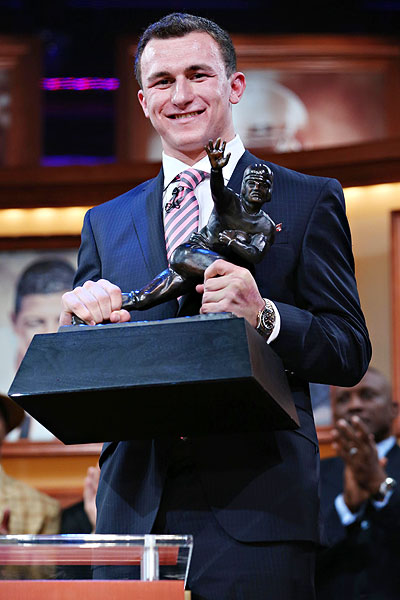RIP Caleb Moore
There are certain times where you try to take an old adage and apply it to different aspects in life. One adage states that there are two things you cannot avoid in life: death and taxes. While taxes are usually a predictable occurrence, the former is something that can put a shock into anyone's spine when it happens unexpectedly.
Thursday, there were news reports that freestyle snowmobile rider and X Games gold medalist Caleb Moore (25) had died after spending a week in the hospital. He had suffered a serious injury while competing in the snowmobile freestyle event at the Winter X Games in Colorado. His death marks the first death in the Games in its 18-year history. Amid this tragedy, people like me begin to wait for scrutiny on the "safety of sports."
I had written about injuries in sports (interestingly enough, a year ago yesterday) before in the blog, and I had mentioned that injuries cannot really be avoided in sports, because if there's strenuous bodily activity involved, freak accidents can happen. An example of this is the story of Al Lucas, a defensive tackle for the Los Angeles Avengers in the Arena Football League. While being tackled during a kickoff, his head collided with another player's knee, resulting in a spinal cord injury from blunt force trauma. To this day, it hasn't been confirmed whether he died on the field or not. There have been even more instances of serious injuries later resulting in death, such as those who have played Australian Rules Football, hockey, soccer, and even in baseball. Some of the sports have seen adjustments to prevent these instances, most notably the institutionalization of a helmet. However, even the usage of padding and helmets can only go so far. Athletes over the years have dropped dead in heat exhaustion and of unexplained cardiac arrest such as those who are cyclists and runners. Most of these cases have occurred in college student athletes and in young children. Why? Nobody can tell. These kinds of things have been happening since the inception of each sport, and it's only becoming a major issue in sports science in this generation.
Precautions are always taken, especially if your child is in a full-contact sport that can lead to serious injury. I should know that myself; I've been tackled and kicked and slid at more times than I can count, and Mom always made sure I wore my mouth guard among other things. Also, I had recently watched a report on Nightline that was talking about the new safety precautions that are being taken for young athletes. Most of these precautions are especially for those who play football. New equipment and technology provided by sports scientists are looking to secure ultimate safety for those who play in the sport. Sure, there are helmets and padding that can withstand collision and such, but we're forgetting one small part of the body that can take all of that and curb-stomp it...
The neck.
 |
| Photo from Wikipedia |
While keeping children safe from these freak accidents is well-spirited measure, it may still open up the gateway to further injury if there are nagging freak injuries or medical conditions that go unnoticed. Even professional athletes can fall victim to this. While there are implemented drug tests in the professional sports world that can pinpoint an underlying heart condition and the like, the damage may already be done in an individual, and the previous strain can wreck an athlete's career and future outside of sports.
______________________________
Despite this, we're still technically animals, and we still think it's really awesome when you see two people beat the snot out of each other in a sport like boxing or MMA. Ah, boxing. There's an example right there. While we have the cases like in the Olympics where there is protective padding worn on the head, the "olden days" of boxing had guys wearing gloves that looked like they barely had enough padding and the sport could practically count as being bare-knuckled. Not only that, but they would fight for what literally seemed like forever or until the guy fell. There are still cases in which men (and women) still fall victim to their fights long afterward. The MMA world isn't safe from this, either. Many men have fallen from brain injuries occurring in-fight and even cases of "second impact syndrome."
Nowadays, people are starting to wonder whether the intensity of hits on the field will lead to deaths on the field in the NFL. Recently, the family of deceased linebacker Junior Seau had sued the NFL over the damages that Seau received during his tenure in the league. There have been recent reports trying to avoid these allegations during this time as well, noting that stricter measures will be taken in the care of athletes, especially when an injury is sustained. Not to sound like "Big Chief Raincloud" again, but the damage has already been done. The disease chronic traumatic encephalopathy (CTE) is something not to be fooled with. Even after one concussion, brain damage is sustained. With that in mind, along with all of the other injuries that can be sustained in football such as broken ribs, arms, and legs, and the tearing of muscles and ligaments, how can this sport be made any safer?
There's the fly in the ointment: what will happen to the sport when things start to become "too safe?"
Bernard Pollard, safety for the Baltimore Ravens, was a player who had made an absolutely devastating tackle on Sunday night, giving New England Patriots running back Stevan Ridley a concussion. After this massive hit, he was interviewed the next day, saying he believes that the NFL might not be around for much longer. On Monday, he had said that if the game is softened too much, people will begin to lose interest in the game and not want to watch if there is no serious hitting involved. Expanding on this idea, this is one of the reasons why nobody really watches the Pro Bowl. It means nothing to the audience, and guys are advised not to hit hard. With that said, we can go back to my "primal instinct" mention from earlier in the post. We want to see guys kill each other out there.
In expanding his previous point, he had also mentioned that after what parents see in this game, they will discourage their children from playing it, even going so far as to saying that he wouldn't even want his own children to play. While some people will disagree with this decision, it's not like he's being an overprotective parent. Let's not lie--football is dangerous. However, cheerleading is dangerous too. Dancing is dangerous. There's a lot of danger all over the place, so you can't exactly avoid the chance of a child getting hurt (unless...they play chess or something).
There have been countless deaths in the world of sports, and although there have been many adjustments made over the past century, things just happen. It's a terrible thing to see, and you can do however you want in order to move on from the terrible incidents, but there's no way that serious injury and death can be avoided in athletics. The human body is a wonderful thing, but there are just times where it breaks down and can't move on any further regardless of training and conditioning.
In the case of Caleb Moore and the death of snowboarder Sarah Burke from last year's post, these young athletes died doing what they loved. It wasn't as if they had committed suicide or had died in a car accident. They died practicing and displaying their talent. Unfortunately, accidents happen. It's a very depressing topic, but this is something that we should reflect on and use as an example that nobody is invincible, no matter how talented or well-conditioned they are. We can protect however much we want, but something like injury and death is something that can never truly be avoided.
--AZ
The Bernard Pollard article can be read here.
Here's to 200 more posts in the future.





